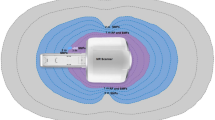Abstract
Purpose
In an attempt to evaluate the exposure level of magnetic resonance imaging (MRI) workers to static magnetic fields, the isotropic magnetic flux density values were integrated over time to produce the cumulative exposure. To protect occupational staff a further precautionary step is proposed by introducing a weighting function incorporating the limits imposed by the Italian legislation. The results obtained should be reported, at the end of each working day, on a special dose card, in order to record each worker’s exposure to the static magnetic field. Moreover, this dose card could be an important tool if long-term effects occur because it provides a complete history of the occupational exposure in an MRI site.
Materials and methods
To conduct measurements, three Hall-sensor probes were used. The consistency of experimental data, tools and methodologies used was evaluated by performing the Kruskal–Wallis test. Finally, the weighted magnitude of the magnetic flux density was integrated over time to obtain global exposure.
Results
Measurements were performed on different MRI scanners ranging from 0.25 up to 3.0 T. The results obtained were compared with the 200 mT·h, which represents the upper limit of the Italian regulation. In no case was the 200 mT·h per day exposure exceeded: however, when the strength of the magnetic field was >200 mT the weighted function overestimated the exposure, so that it represents a highly precautionary measure taking into account possible acute and long-term effects. In addition, from the data recorded during patient positioning operations by MRI staff the dB/dt curve was obtained.
Conclusions
The areas obtained from the integral of the weighted static magnetic field strength over time can be indicative of the global exposure of the occupational staff. These values should be reported on a special dose card that could be considered as an important tool if long-term effects occur because it provides a complete history of the occupational exposure in an MRI site.



Similar content being viewed by others
Notes
D.M. 02/08/1991.
Directive 2004/40/EC of the European Parliament and of the Council of 29 April 2004 on the minimum health and safety requirements regarding the exposure of workers to the risks arising from physical agents (electromagnetic fields) (18th individual Directive within the meaning of Article 16(1) of Directive 89/391/EEC).
Directive 2008/46/EC of the European Parliament and of the Council of 23 April 2008 amending Directive 2004/40/EC on minimum health and safety requirements regarding the exposure of workers to the risks arising from physical agents (electromagnetic fields) (18th individual Directive within the meaning of Article 16(1) of Directive 89/391/EEC).
Directive 2012/11/EU.
References
International Commission on Non-Ionizing Radiation Protection (2004) Medical magnetic resonance (MR) procedures: protection of patients. Health Phys 87:197–216
International Commission on Non-Ionizing Radiation Protection (2009) ICNIRP guidelines on limits of exposure to static magnetic fields. Health Phys 96:504–514
IEEE C95.6 (2002) Standards for safety levels with respect to human exposure to electromagnetic fields (0–3 kHz). IEEE, New York
Vermiglio G, Sansotta C, Tripepi MG, Testagrossa B (2003) Monitoraggio dell’esposizione a Campi Magnetici Statici. Proceedings XXXII Congresso Nazionale AIRP
Neutra RR (2005) Glossary of terms used when discussing exposure to electric and magnetic fields. J Epidemiol Commun 59:546–550
Karpowicz J, Gryz K (2006) Health risk assessment of occupational exposure to a magnetic field from magnetic resonance imaging devices. Int J Occup Saf Ergo 12:155–167
Fuentes MA, Trakic A, Wilson SJ, Crozier S (2008) Analysis and measurements of magnetic field exposures for healthcare workers in selected MR environments. IEEE Trans Bio-Med Eng 55:1355–1364
Crozier S, Trakic A, Wang H, Liu F (2007) Numerical study of currents in workers induced by body-motion around high-ultrahigh field MRI magnets. J Magn Reson Imaging 26:1261–1277
Institute of Electrical and Electronics Engineers (IEEE) (2002) C95.6: Standard for safety levels with respect to human exposure to electromagnetic fields (0–3 kHz). IEEE 21, New York
Glover PM, Cavin I, Qian W et al (2007) Magnetic-field-induced vertigo: a theoretical and experimental investigation. Bioelectromagnetic 28:349–361
Glover PM, Bowtell R (2008) Measurement of electric fields induced in a human subject due to natural movements in static magnetic fields or exposure to alternating magnetic field gradients. Phys Med Biol 53:361–373. doi:10.1088/0031-9155/53/2/005
de Vocht F, Muller F, Engels H, Kromhout H (2009) Personal exposure to static and time-varying magnetic fields during MRI system test procedures. J Magn Reson Imaging 30:1223–1228
Acknowledgments
The authors wish to thank F. Campanella (INAIL), M. Mattozzi (INAIL), Milani and Ferrari for the passionate and critical exchange of opinions. The authors also thank Tecnorad for providing the dosimeter and for assistance during data managing.
Conflict of interest
Giuseppe Acri, Testagrossa Barbara, Causa Federica, Tripepi Maria Giulia, Vermiglio Giuseppe, Novario Raffaele, Pozzi Liviana, Quadrelli Gloria declare no conflict of interest.
Author information
Authors and Affiliations
Corresponding author
Rights and permissions
About this article
Cite this article
Acri, G., Testagrossa, B., Causa, F. et al. Evaluation of occupational exposure in magnetic resonance sites. Radiol med 119, 208–213 (2014). https://doi.org/10.1007/s11547-013-0324-5
Received:
Accepted:
Published:
Issue Date:
DOI: https://doi.org/10.1007/s11547-013-0324-5




